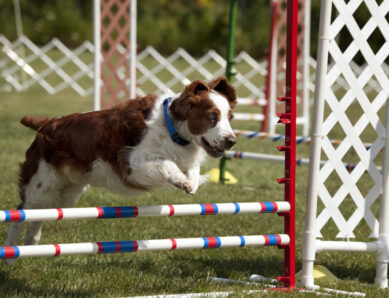It’s early morning on a day when most sensible people are still in bed. But I’m far from home, in a dew-soaked field, under an ominous gray sky.
This is pretty standard for me. I’m an agility addict and, most weekends throughout the summer, you’ll find me and my dogs competing at various venues around the U.K.
On this particular occasion, I have traveled more than 100 miles to compete in my first Championship event. All the top U.K. handlers are here, including my agility heroes: triple world champion Natasha Wise, European Champion and two-times Crufts winner Sian Illingworth, and (my daughter’s favorite) TV and film celebrity duo Ashleigh Butler and Pudsey.
I know I don’t stand a chance of winning this event, but it’s still important that I give it my best shot. I need to get “in the zone.”
Getting “In the Zone,” Doggy-Style!
The first step is to “walk the course.” This is how the handlers learn the correct combination of obstacles and we decide how to tackle it with our dogs. There are an infinite number of ways that any course can be handled. We each have our different styles and preferences – as do our dogs – and we develop our individual strategies accordingly.
Course-walking is an art form in itself. The top handlers will maybe do this twice – often while wearing dark glasses and headphones to shut out distractions. Personally, I like to walk the course five times. While walking, I mentally visualize how my dog will move around the course, trying to imagine what it will look like from her perspective, and thinking about how I can communicate what I want her to do as clearly as possible.
After that, we all go back to our cars to collect our dogs and prepare for the 30-or-so seconds when we will perform, under the eagle eye of the judge. Getting “in the zone” is a very personal experience and each handler has his or her own little ritual.
I have a slightly different routine for each of my dogs, but Twinkle’s is the most elaborate. We start with a physical warm-up routine, which involves a sequence of walking, jogging, figure-eights, and sprint starts. She often has pre-competition nerves, so we play games to release any tension. When she’s excited, but happy, I take off her collar so she knows it’s time to go to work.
While we wait for our turn, I go over the course in my head, visualizing how we will run it. We practice a few tricks together, and Twinkle limbers up with a stretching ritual of her own design. We’re almost ready to run.
Now we approach the start line and I guide Twinkle to the position that gives her the best angle. The official starter tells me, “When you’re ready, Ruth.” I take Twinkle’s head in both hands, gently tug on her ears, give her a quick kiss, and stride out to my starting position, resisting the temptation to look back and check on her.
When I’m ready, I touch the good luck charm on my necklace. I take a deep breath… hold it, let it out, then turn, look Twinkle in the eye, and say, “Ready, ready… GO!”
For a few brief, exhilarating seconds, all that exists is me, my dog, and the course. Then, it’s all over and, regardless of whether we win or go bust, I go wild and tell my dog how fantastic she is (as the saying goes in dog sports, “I always take the best dog home”).
Superstitious Nonsense?
You might think that this is all superstitious nonsense, but pre-performance rituals (PPRs) like these are commonplace – not only in dog agility, but in all sports, and especially among top sports professionals. Michael Jordan famously wore his college basketball shorts beneath his Chicago Bulls uniform. Tiger Woods wears a red shirt on the last day of each golf tournament, and Serena Williams wears the same pair of socks for the duration of a tennis match and bounces each ball five times before she serves.
It’s not only sports people who adopt such rituals, either. Performance coach consultant Bill Cole believes that everyone – actors, musicians, public speakers, teachers, sales people, and more – can benefit from using them to get “in the zone.”
The use of rituals seems ingrained in human nature and crosses all cultures and religions. According to research, people are most likely to use rituals when the stakes are high, the outcome is important, and the result is uncertain or perceived as being beyond their personal control.
Evidence suggests that, despite being largely dismissed as irrational, good luck rituals such as saying “break a leg,” keeping your fingers crossed, or carrying a lucky charm can improve attention and execution, increase emotional stability, build confidence, and raise performance levels in a multitude of activities.
In one study, volunteers who were allowed to keep their lucky charms with them during a test performed significantly better than those who were told they could have them back at the end.
In another experiment, the same researchers found that just telling someone you were keeping your fingers crossed for them, or that they were using a “lucky ball,” enhanced their performance.
Focusing in on Success
So, whenever you need to perform at your best, try using a ritual of your own. It may be that you already have a lucky charm that brings you comfort, but try not to become overly reliant on an object that could be mislaid at a crucial moment. Better to develop a simple pre-performance ritual that you can call upon whenever you need it.
My own PPR incorporates elements from familiar techniques like Snyder’s Hope Theory, Visualization, Imagery, and Centering, but even invented rituals can be beneficial, so don’t be afraid to embrace your little quirks or even adopt a new one.
I wouldn’t say that my rituals bring me luck, exactly. On the day of the agility championship, I made a silly mistake that got us knocked out of the contest in the first round! But, on reflection, my error was down to poor planning, rather than bad execution. The pre-performance ritual, at least, kept me calm and focused in the heat of the moment.
How do you prepare for those important situations that put you to the test? Do you have some lucky shorts, perhaps? Or do you perform some kind of ritual to get “in the zone?” Share your tips below.




Comments
Yolande Conradie says
10 years agoListening to classical music on my way to a client helps me get in the zone. I "pre-play" the situation in my head and I see it with a successful outcome.
Mark Laker says
10 years agoGreat article and as an agility competitor and someone who runs seminars on applying sports psychology to dog agility you're spot on.
Midgie Thompson says
10 years agoThanks for sharing. I agree that we can apply the principles of sports psychology in any performance area of our lives. Whether it is for a job interview, a presentation or a sporting competition, the same principles to prepare and get into the zone can apply.
Ruth says
10 years agoThanks, Mark! It's good to know that I'm barking up the right tree (ha ha).